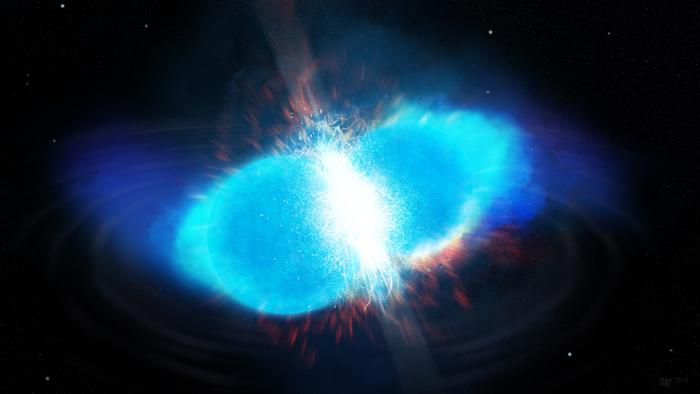
Scientists have discovered the first indication of nuclear fission occurring amongst the stars. The discovery supports the idea that when neutron stars smash together, they create "superheavy" elements — heavier than the heaviest elements of the periodic table — which then break down via nuclear fission to birth elements like the gold in your jewelry.
Nuclear fission is basically the opposite of nuclear fusion. While nuclear fusion refers to the smashing of lighter elements to create heavier elements, nuclear fission is a process that sees energy released when heavy elements split apart to create lighter elements. Nuclear fission is pretty well known, too. It's actually the basis of energy-generating nuclear power plants here on Earth — however, it had not been seen occurring amongst the stars before now.
"People have thought fission was happening in the cosmos, but to date, no one has been able to prove it," Matthew Mumpower, research co-author and a scientist at Los Alamos National Laboratory, said in a statement.
The team of researchers led by North Carolina State University scientist Ian Roederer searched data concerning a wide range of elements in stars to discover the first evidence that nuclear fission could therefore be acting when neutron stars merge. These findings could help solve the mystery of where the universe's heavy elements come from.
Related: What happens when neutron stars collide? Astronomers may finally know
Scientists know that nuclear fusion is not just the primary source of energy for stars, but also the force that forges a variety of elements, the "heaviest" being iron.
The picture of so-called nucleosynthesis for heavier elements like gold and uranium, however, has been somewhat more mysterious. Scientists suspect these valuable and rare heavy elements are created when two incredibly dense dead stars — neutron stars — collide and merge, creating an environment violent enough to forge elements that can't be created even in the most turbulent hearts of stars.
The evidence of nuclear fission discovered by Mumpower and the team comes in the form of a correlation between "light precision metals," like silver, and "rare earth nuclei," like europium, showing in some stars. When one of these groups of elements goes up, the corresponding elements in the other group also increases, the scientists saw.
The team's research also indicates that elements with atomic masses — counts of protons and neutrons in an atomic nucleus — greater than 260 may exist around neutron star smashes, even if this existence is brief. This is much heavier than many of the elements at the "heavy end" of the periodic table.
"The only plausible way this can arise among different stars is if there is a consistent process operating during the formation of the heavy elements," Mumpower said. "This is incredibly profound and is the first evidence of fission operating in the cosmos, confirming a theory we proposed several years ago."
"As we’ve acquired more observations, the cosmos is saying, 'hey, there’s a signature here, and it can only come from fission.'"
Neutron stars and nuclear fission
Neutron stars are created when massive stars reach the end of their fuel supplies necessary for intrinsic nuclear fusion processes, which means the energy that has been supporting them against the inward push of their own gravity ceases. As the outer layers of these dying stars are blown away, the stellar cores with masses between one and two times that of the sun collapse into a width of around 12 miles (20 kilometers).
This core collapse happens so rapidly that electrons and protons are forced together, creating a sea of neutrons so dense a mere tablespoon of this neutron star "stuff" would weigh more than 1 billion tons if it were brought to Earth.
When these extreme stars exist in a binary pairing, they spiral around one another. And as they spiral around one another, they lose angular momentum because they emit intangible ripples in spacetime called gravitational waves. This causes neutron stars to eventually collide, merge and, unsurprisingly given their extreme and exotic nature, create a very violent environment.
This ultimate neutron star merger releases a wealth of free neutrons, which are particles normally bound up with protons in atomic nuclei. This can allow other atomic nuclei in these environments to quickly grab these free neutrons — a process called rapid neutron capture or the "r-process." This allows the atomic nuclei to grow heavier, creating superheavy elements that are unstable. These superheavy elements can then undergo fission to split down into lighter, stable elements like gold.
In 2020, Mumpower predicted how the "fission fragments" of r-process-created nuclei would be distributed. Following this, Mumpower’s collaborator and TRIUMF scientist Nicole Vassh calculated how the r-process would lead to the co-production of light precision metals such as ruthenium, rhodium, palladium and silver — as well as rare earth nuclei, like europium, gadolinium, dysprosium and holmium.
This prediction can be tested not only by looking at neutron star mergers but also by looking at the abundances of elements in stars that have been enriched by r-process-created material.
This new research looked at 42 stars and found the precise correlation predicted by Vassh, thus showing a clear signature of the fission and decay of elements heavier than found on the periodic table, further confirming that neutron star collisions are indeed the sites where elements heavier than iron are forged.
"The correlation is very robust in r-process enhanced stars where we have sufficient data. Every time nature produces an atom of silver, it’s also producing heavier rare earth nuclei in proportion. The composition of these element groups are in lockstep," Mumpower concluded. "We have shown that only one mechanism can be responsible — fission — and people have been racking brains about this since the 1950s."
The team’s research was published in the Dec. 6 edition of the journal Science.







